
The lanceolated warbler is an Old World warbler in the grass warbler genus Locustella. It breeds from northeast European Russia across northern Asia to northern Hokkaidō, Japan. It is migratory, wintering in south-east Asia. The genus name Locustella is from Latin and is a diminutive of locusta, "grasshopper". This refers to the song of the common grasshopper warbler and some others in this genus. The specific lanceolata is Latin for "spear-shaped" and refers to the streaks on the breast.

Portulaca is the type genus of the flowering plant family Portulacaceae, comprising about 40-100 species found in the tropics and warm temperate regions. They are also known as purslanes.
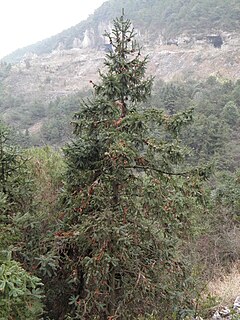
Cunninghamia is a genus of one or two living species of evergreen coniferous trees in the cypress family Cupressaceae. They are native to China, northern Vietnam and Laos, and perhaps also Cambodia. They may reach 50 m (160 ft) in height. In vernacular use, it is most often known as Cunninghamia, but is also sometimes called "China-fir". The genus name Cunninghamia honours Dr. James Cunningham, a British doctor who introduced this species into cultivation in 1702 and botanist Allan Cunningham.

Plantago lanceolata is a species of flowering plant in the plantain family Plantaginaceae. It is known by the common names ribwort plantain, narrowleaf plantain, English plantain, ribleaf and lamb's tongue. It is a common weed of cultivated land.

Coreopsis lanceolata, the Lance-leaved coreopsis, is a North American species of Tickseed in the sunflower family. It is apparently native to the eastern and central parts of the United States and naturalized in Canada, the western United States, Mesoamerica, South America, South Africa, eastern Australia and eastern Asia.
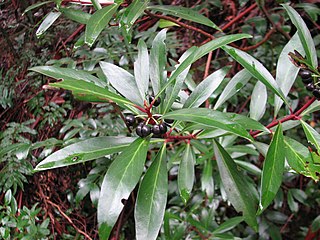
Tasmannia lanceolata, commonly known as Tasmanian pepperberry, mountain pepper (Aus), or Cornish pepper leaf (UK), is a shrub native to woodlands and cool temperate rainforest of south-eastern Australia. The shrub varies from 2 to 10 m high. The aromatic leaves are lanceolate to narrow-elliptic or oblanceolate, 4–12 cm long, and 0.7–2.0 cm wide, with a distinctly pale undersurface. Stems are quite red in colour. The small cream or white flowers appear in summer and are followed by black, globose, two-lobed berries 5–8 mm wide, which appear in autumn. There are separate male and female plants.
Kokia lanceolata, the Wailupe Valley treecotton, was a species of flowering plant in the Malvaceae family. It was the only species of Kokia to occur on the island of Oahu and originally known from the hills of Makapu'u, Koko Head and Wailupe Valley. It became extinct not long after its discovery in the 1880s, most likely due to grazing pressure from cattle and goat ranching.

The crested gallito is a species of bird in the family Rhinocryptidae. It is monotypic within the genus Rhinocrypta. It is found in Argentina, Bolivia, and Paraguay, where its natural habitats are subtropical or tropical dry forests and subtropical or tropical dry shrubland.
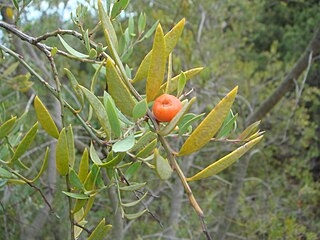
Osyris lanceolata, the African sandalwood, is used for its scented wood and to extract essential oil. The hemi-parasitic plant is found from South Africa to Zimbabwe and east Africa, including Tanzania, Kenya and Uganda. It grows in rocky areas or along the margins of dry forest, but is usually not abundant in any one place.

Dudleya lanceolata is a succulent plant known by the common name lanceleaf liveforever. This plant is native to the mountains of Southern California and Baja California, where it is found in rocky areas and slopes.
Ulmus parvifolia f. lanceolata, the Chinese elm, is a rare form endemic to South Korea.

Melaleuca lanceolata commonly known as black paperbark, moonah, Rottnest Island teatree and western black tea tree is a plant in the myrtle family, Myrtaceae and is native to Australia where it occurs in Western Australia, South Australia, Victoria, New South Wales and Queensland. It is a densely foliaged tree with rough bark, which flowers prolifically in summer.
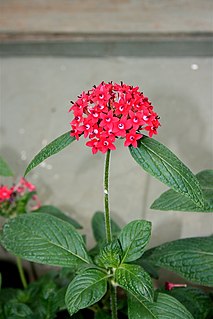
Pentas lanceolata, commonly known as Egyptian starcluster, is a species of flowering plant in the madder family, Rubiaceae that is native to much of Africa as well as Yemen. It is known for its wide use as a garden plant where it often accompanies butterfly gardens.

Persoonia lanceolata, commonly known as lance-leaf geebung, is a shrub native to New South Wales in eastern Australia. It reaches 3 m (9.8 ft) in height and has smooth grey bark and bright green foliage. Its small yellow flowers grow on racemes and appear in the austral summer and autumn, followed by green fleshy fruits which ripen the following spring. Within the genus Persoonia, P. lanceolata belongs to the lanceolata group of 58 closely related species. It interbreeds with several other species found in its range.
Persoonia glaucescens, commonly known as the Mittagong geebung, is a shrub native to New South Wales in eastern Australia. It was formerly known as Persoonia lanceolata subspecies B. It is currently classified under Commonwealth legislation as vulnerable, and is listed in New South Wales legislation as endangered.
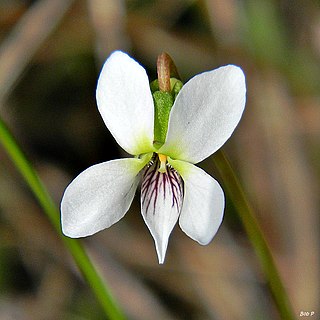
Viola lanceolata, commonly known as lance-leaved violet or bog white violet, is a small group of stemless white-flowered violets. It is an ornamental plant in the Violaceae family, part of the genus Viola. It gets its name from its lanceolate leaf shape and from the habitats in which it thrives.
Unaporanga is a genus of longhorn beetles of the subfamily Lamiinae, containing the following species:
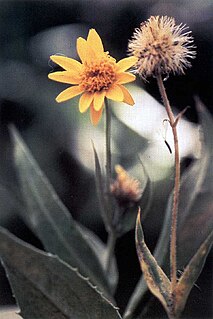
Arnica lanceolata is a North American species of arnica in the sunflower family, known by the common name clasping arnica or lanceleaf arnica. It has a disjunct (discontinuous) distribution in western North America and northeastern North America.
Unaporanga cincta is a species of beetle in the family Cerambycidae. It was described by Martins and Galileo in 2007. It is known from Panama.

Mertensia lanceolata, known as prairie bluebells, lance-leaved bluebells, and lance-leaved lungwort is a species of flowering plant native to western North America. Accepted varieties include:
















